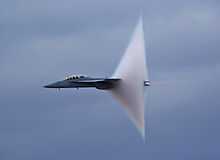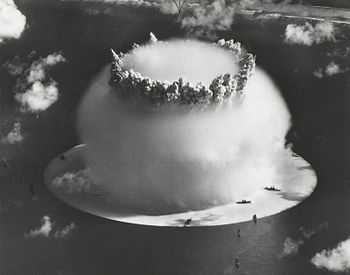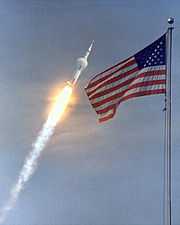Vapor cone

A vapor cone, also known as shock collar or shock egg, is a visible cloud of condensed water which can sometimes form around an object. A vapor cone is typically observed as an aircraft, or object, approaches transonic velocity. Atmospheric water then condenses, and thus becomes visible, as air pressure varies suddenly across shock waves associated with supersonic flow speed.
Atmospheric condensation around aircraft is also associated with low-pressure regions in subsonic flight, and can typically be observed in damp conditions; but this does not result in conical condensation clouds.
Condensation cones appear in what was described as a Prandtl-Glauert singularity.[1] In addition to making the shock waves themselves visible, water condensation can also occur in the trough between two crests of the shock waves produced by the passing of the object. However, this effect does not necessarily coincide with the acceleration of an aircraft through the speed of sound or Mach 1.[1][2]
Examples
These condensation clouds can often be seen appearing round space-bound rockets as they accelerate through the atmosphere. For example, they were frequently seen during Space Shuttle launches, about 25 to 33 seconds after launch, when the vehicle was traveling at transonic speeds. Similar effects were also visible in archival footage of some nuclear tests. Scientists observing the Operation Crossroads nuclear tests in 1946 named the transitory cloud a "Wilson cloud" for its superficial similarity to the Wilson cloud chamber effect.[3]
Gallery
Click on the thumbnail to enlarge.
-

Operation Crossroads, a nuclear explosion at the Bikini Atoll
-
.jpg)
Ares I-X Test Rocket during launch October 28, 2009
-
.jpg)
F/A-18 at transonic speed
-

F/A-18E at transonic speed
-
_113_breaks_the_sound_barrier_during_an_air_power_demonstrati.jpg)
Complex set of condensation cones surround a F/A-18 at transonic speed
See also
References
- ↑ 1.0 1.1 Britt, Robert. "What Supersonic Looks Like|LiveScience". Livescience.com. Retrieved 2012-10-31.
- ↑ Wilkinson, Jeff. "Wilk4: Breaking the Sound Barrier (and Vapor Cones around Jets)". Wilk4.com. Retrieved 2012-10-31.
- ↑ "Operation Crossroads: Fact Sheet". History.navy.mil. Retrieved 2012-10-31.
External links
| Wikimedia Commons has media related to Aerodynamic condensation from shockwaves. |
